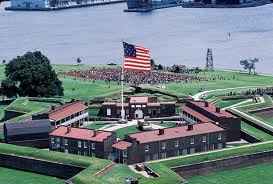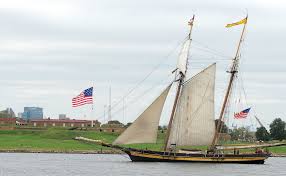Baltimore MD, 6-19-14
It is the 200th anniversary year of the Star-Spangled Banner. I am visiting the city with Mindy. It is my first physical trip to Baltimore ever, but only one of many visits I have made through my 54 years. My primary goal was to relax on vacation, my first in several years. I forgot that goal, and the books I brought to aid in my retreat, in the excitement growing inside me at being in the city and so near the flying of the Star-Spangled Banner.
I am, in my limited capacity, a historian by collecting things through my life I have observed were important to lives past. This trip I collected a symbol of America and intended it might become a small symbol to my family of the American Spirit, believing in the good accomplished by Americans through the centuries in a time when so many work to destroy that same spirit. I still believe!
So, with purposeful intend and to the exclusion of the reading, swimming, relaxations I should have given myself, I inserted the anxious uncertainty of travel, timing, and questionable opportunity of the purchase of some colored nylon to fly for only a few moments over a fortress no longer in use as such. Many, if not most, would call me crazy, certainly in need of a longer vacation. A few might recommend commitment. Why do this? The ‘whys’ of history are important to posterity.
Because the Star-Spangled Banner, the flag and the song, represent a country coming of age. Because it marks the first time the commitment to the idea that was born in the Declaration of Independence passed to and was defended by a new generation of Americans. Because the idea of the Declaration was once again defended by men, women, and even children alongside the few professionals that practiced ware at sea and ashore. The rich and prosperous stood with the laborers and servants, the free and enslaved blacks stood beside the whites. They all had the same things to lose. Homes, wharfs, businesses, ships, and food stores would be destroyed. The city of Washington D.C. was burned to the ground, including the White House and a yet unfinished Capitol building.
I leave the details of the knowledge of the war, including Baltimore’s role as a ‘nest of pirates’ to those dedicated to learning them and the professional historians. My interest began as a youth, perhaps because I am a child of the Bicentennial celebrations of the United States. I first learned of the Star-Spangled Banner around the age of ten. My parents purchased a volume of history books for children and I read every one. The story of Fort McHenry was in of those stories. And, to add depth, Mr. Key was standing on the deck of a sailing ship when he saw that Banner flying after the battle. I had been reading sailing stories for three years before getting this volume in hand. I read of the whaling fleets of the east coast ports, of John Paul Jones and Stephen Decatur, of the Constitution (Old Ironsides) and of the Perrys, one fighting on Lake Erie and one sailing to Japan. I was a sailor at heart as a boy with two feet firmly planted in the middle of Ohio farmland. Francis Scott Key was on the deck of a ship, sailing out to gain the release of a friend captured in Washington’s burning when both were detained before the battle for Baltimore. It is a sailor’s story, even if Mr. Key was a lawyer.
The Star-Spangled Banner as a song has been derided and disparaged since it was written and down through time. First, it was criticized because the tune it was set to is a drinking song. Later, Key’s grandson was imprisoned in the same Fort it flew over because he used his newspaper to voice his opposition to President Lincoln’s policies during the Civil War. It was argued that the song was so limited in scope, being about an obscure battle in an obscure war when the Congress and the country were debating what song should be our national anthem through the early 20th century. By mid-century people were burning flags in protest of the government policies and by the end of the 20th century artists were lauded in high social circles for their works where people stood on the flags and the artists splattered feces on the flags. Children in schools no longer have to pledge allegiance to the flag. Military service is all-volunteer, so less than ten percent of the nation has ever had to defend the flag with their lives. What was a symbol of coming of age of a nation is now so much about controversy. The song that gave so much excitement and confidence to a nation beaten down by war has become a nominal ritual at sporting events and few know the full verse of the poem.
I first served the flag as a color guard rifle bearer when I was ten. I saluted it and folded it as a Boy Scout, and tended its daily flying over our home with my sisters. I learned to sing about it and I learned all the verses at one time. Mindy and I still break into our bass and alto parts whenever we sing it, especially in crowds when others are silent or distracted. I served 20 years in the Navy and deployed six times for Norfolk, VA, including from 1990Aug ‘til 1991March for Operation Desert Shield and Desert Storm in the First Gulf War. Each time my ships returned I strove to be on deck and look to Fort Story on the south side of Hampton Roads channel into the Chesapeake Bay. I had no reason to doubt, ever, but Mr. Key’s question always resounded in my mind; “O say, does that Star-Spangled Banner yet wave…” I wanted to see that it did, similar to how Key saw it, where the fog of the sea and the haze of the land meet.
Fort McHenry is on the north end of the Chesapeake Bay while Fort Story is on the south end. Land and sea still create a fog and haze mix that may at times obscure the view of the flag over Fort McHenry. It was not so on the day of my visit. On Tuesday evening prior, from the upper deck of a dinner cruise ship, I saw the fort outline, back lit by the sunset, by a sky so blazingly bright orange that the fort was but an inky shadow in front of it. The day of June 18th, 2014, I would step ashore from the water taxi under a blazing sun, bright blue sky, and a wind growing to fifteen knots and beyond. I knew I was on hallowed ground, for from here Americans would finally know they had a manifest destiny.
Park Ranger Elizabeth White, a theology student at The Franciscan University, Steubenville OH and a self-described ‘navy brat’ of Annapolis MD, helped me hoist my new flag the 92’ over Fort McHenry. We let the flag fly for about five minutes next to the existing garrison banner. Together, we lowered the flag and folded it. We tied off the hoist and I unfolded the hoist edge of the new banner. I marked it with the date and asked Ranger White to write her name and position. I was creating a piece of history, and this I hope will aid in authenticating the flag, if desired, in the future.
My hope is that my children, grandchildren, and future generations will find among themselves someone who will care for this 200th anniversary banner, that they will return it to Fort McHenry every 25 years and hoist it once again. My hope is, that as the George Armistead family cared for the original banner, my family will care for this banner, and will ask the question asked by Francis Scott Key with the same anxiety and fervor,
“O say, does that Star-Spangled Banner yet wave, ‘ore the land of the free and the home of the brave?”
John L. Zoll
June 19th, 2014
http://www.ushistory.org/documents/banner.htm
http://www.ushistory.org/documents/pledge.htm
The original handwritten story is kept with the flag in an unremarkable college ruled notebook. My wife suggested it be used by those who make the trip back to Baltimore with the flag and record their trips. There is also a DVD produced for the National Park Service that tells (told) the story at the Fort’s visitor center. (There, at the end of the film, they raise the movie screen while playing the song. Behind the screen is a window looking up the hill at the fort with one of the weather appropriate banners waving in the breeze.)
These items will remain together as Providence allows. I hope they will inspire others to be so dedicated to the values professed in the documents of our American experiment, and those so professed through the years.


